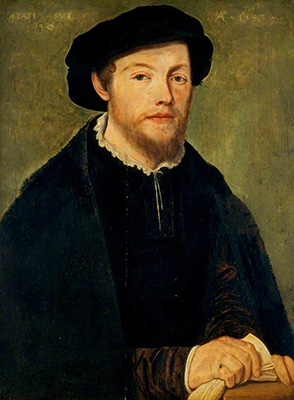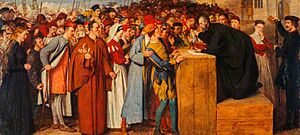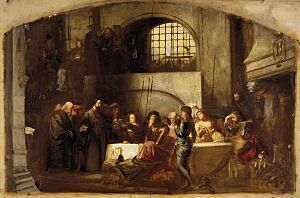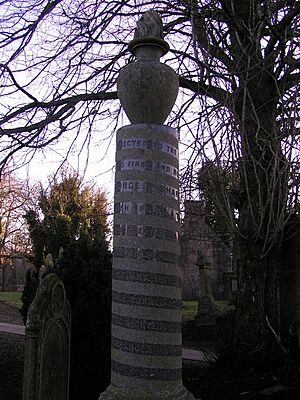George Wishart facts for kids
Quick facts for kids
George Wishart
|
|
|---|---|
 |
|
| Born | c. 1513 Kincardineshire, Scotland
|
| Died | 1 March 1546 (aged 32–33) St Andrews, Scotland
|
| Alma mater | University of Aberdeen University of Leuven Corpus Christi College, Cambridge |
| Occupation | Preacher |
George Wishart (born around 1513 – died March 1, 1546) was an important figure in the Scottish Reformation. He was a Protestant reformer who believed in different religious ideas than the main church at the time. Because of his beliefs, he was seen as a heretic and was executed. He is remembered as one of the early Protestant martyrs in Scotland.
Wishart came from a family that supported the Reformation. He studied at the University of Aberdeen and also traveled in Europe. It was during his travels that he likely became interested in the new Protestant ideas. He taught Greek in Montrose for some time. Later, he spent about six years studying and teaching at Corpus Christi College, Cambridge in England.
In 1543, Wishart returned to Scotland. He came with Scottish officials who were discussing a marriage between Mary, Queen of Scots and Prince Edward. Wishart began preaching to people in places like Montrose, Dundee, and Ayrshire. He spoke about his Reformed beliefs. As he traveled, he knew he was in danger.
While in East Lothian, Wishart was captured by Lord Bothwell. This happened on the orders of Cardinal David Beaton, a powerful church leader. Wishart was taken to St Andrews and put on trial by church leaders. He was found guilty of being a heretic. The very next day, he was executed by burning at the stake on Castle Green. Cardinal Beaton watched from his castle windows. Interestingly, Beaton himself was killed just three months later.
Contents
George Wishart's Early Life and Education
George Wishart was born into a family from Pitarrow in Kincardineshire, Scotland. His mother, Elizabeth, married James Wishart of Pitarrow in 1512. George was likely named after his mother's family. His father passed away in 1525, so his mother and her brother, Sir James Learmonth, raised him.
Wishart studied at the University of Leuven in Belgium, graduating in 1531. Around this time, he translated an important Protestant document, the First Helvetic Confession, from Latin into English. He later taught the New Testament in Greek at a school in Montrose. However, he faced accusations of heresy from a bishop in 1538.
Wishart's Time in England and Return
Because of the heresy charges, Wishart fled to England. He faced similar accusations in Bristol in 1539. Under questioning by Archbishop Thomas Cranmer, he changed some of his statements. He might have visited Germany and Switzerland around 1539 or 1540. By 1542, he was studying and teaching at Corpus Christi College, Cambridge in England.
In 1543, Wishart returned to Scotland. He came back with a group of Scottish ambassadors. They were in London to discuss a possible marriage treaty. This treaty was about marrying the young Scottish Queen, Mary, to Prince Edward of England. After returning, Wishart continued to teach about the Bible in Montrose.
Wishart's Preaching Journeys
George Wishart began his journeys as a traveling preacher in 1544. He traveled across Scotland, sharing his religious ideas. His student, John Knox, later wrote about Wishart's travels. Wishart often faced danger as he spoke out against the Papacy and problems within the church.
He preached in many towns, including Montrose and Dundee. In Dundee, someone even tried to kill him. He also preached in Ayr, Perth, Edinburgh, Leith, and Haddington. John Knox traveled with him during his time in Haddington.
Arrest, Trial, and Execution
In January 1546, George Wishart was captured in Ormiston in East Lothian. Lord Bothwell arrested him on orders from Cardinal Beaton. Wishart was first taken to Elphinstone Castle. On January 19, 1546, he was moved to Edinburgh Castle.
From Edinburgh Castle, Wishart was handed over to Cardinal Beaton. Beaton arranged a trial for Wishart. John Lauder was the prosecutor. Wishart was found guilty and executed on March 1, 1546. Some historians say Wishart predicted Cardinal Beaton's death. Beaton was killed on May 29, 1546, partly as revenge for Wishart's execution.
Wishart's preaching helped spread the ideas of reformers like Calvin and Zwingli in Scotland. During his trial, he disagreed with some church teachings. For example, he did not believe that confession was a sacrament. He also believed that all Christians could be priests. He taught that the true Church was where God's Word was taught and the two main sacraments were correctly performed.
Memorials to George Wishart
Many places remember George Wishart today. The Martyrs Memorial in St Andrews honors him. It also remembers Patrick Hamilton and other people who died for their beliefs during the Scottish Reformation.
In Dundee, the East Port, also called Cowgate Port, is known as the Wishart Arch. It is the only part of the old town walls that still stands. There's a story that George Wishart preached from this arch in 1544 to people suffering from the plague. However, this story is likely a myth. The arch was probably built around 1590, long after Wishart died.
A church in Dundee was also named after Wishart. Wishart Church was built in 1841 and could hold over 700 people. The famous missionary Mary Slessor was a member of this church when she lived in Dundee. The church later changed its name to Wishart Memorial Church. Today, the building is used by Dundee Cyrenians, a charity. There is also a house named after him at Saint Kentigern College in Auckland, New Zealand.
See also
- Patrick Hamilton (martyr)
- John Ogilvie (saint)
- List of Protestant martyrs of the Scottish Reformation










